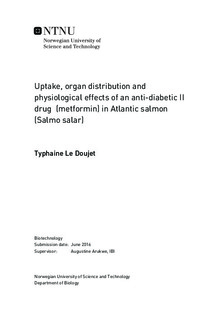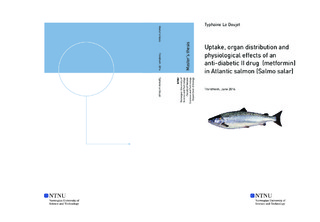| dc.description.abstract | Pharmaceutical and personal care products (PPCPs) are recognized as emerging contaminants due to their high occurrence and persistence in the environment. Metformin is an anti-diabetic II drug and one of the most prescribed PPCPs and found in relatively high concentration in the environment. Upon metformin ingestion by diabetic people, the drug is not metabolized and is excreted as non-modified molecule in the urines to reach the treatment facilities where it is unfortunately not well degraded. Metformin can reach the aquatic environment where aquatic organism might absorb the drug and probably result in its way back up to the food chain. Some studies has showed relatively high amount of metformin in sludge and waste water treatment plants. Therefore, it is important to perform health risk assessment on such xenobiotic and for that it is necessary to have good knowledge about PPCPs chemical structure, uptake and translocation, and physiological effect in aquatic species. However, there is lack of data concerning fish and particularly with metformin. In this study, the uptake, organ distribution and physiological effects of metformin in Juvenile Atlantic salmon (Salmo Salar) were investigated. Four group containing respectively five Juvenile Atlantic salmon were exposed to different concentrations of metformin (0, 5, 50 or 500µg/L) during 3, 7 and 10 days. Chemical analysis was performed in order to determine uptake, distribution in organ of the drug. Gene expression was performed with Real-time RT-PCR in order to analyse the transcript level of various genes. First, StAR and P450scc genes, involved in the steroidogenesis were investigated in the brain. Other genes including those responsible for phase I and II biotransformation (cyp1a1, cyp3a, GST), multi-xenobiotic transporters (P-glycoprotein and multi-R) and protection against oxidative stress was also studied. In addition, biochemical analysis was performed in order to determine the functional level of the two key proteins in the steroidogenesis (StAR and P450scc) with immunochemical analysis (western blot) and also the enzyme activity of four selected antioxidant enzymes were performed spectrophotometrically. Finally, the potential neurotoxicity of metformin was investigated by the determination of acetylcholine esterase (AChE) activity. This study identified overall uptake of metformin which was found to be the highest in gills, but still at a relatively low concentration level. Metformin caused temporarily increase in the gene expression of StAR and P450scc gene, but without change in protein expression. The two biotransformation enzymes cyp1a1 and cyp3a were either inhibited or increased depending on time exposure, but without showing much concentration dependence. No toxicity by accumulation of exogenous and endogenous compounds was apparent due to absence of important inhibition for the two multi-xenobiotic resistance proteins p-gp and multi-R. The organic anion transporters were not affected by metformin. It appears that oxidative stress was not induced upon metformin treatment. Finally, metformin did not induce neurotoxicity in Juvenile Atlantic salmon. Overall, metformin seems to cause some biological response in juvenile Atlantic salmon without potential biological effects. Further study is required to confirm the bio and experimental variations. | |

